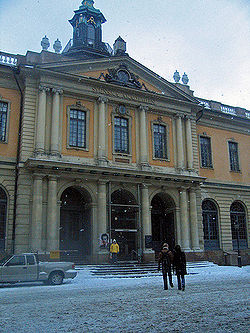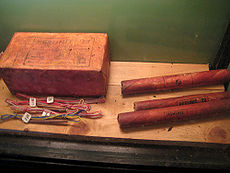Alfred Nobel
Alfred Nobel is a Swedish chemist who is very well-known to invent a dynamite. In his family, he had a father, Immanuel Nobel, a mother, Andriette Nobel and two brothers, Robert and Ludvig. When he was young, he was fluent in five different languages and was first very interested in English literature and poetry. In 1866, he discovered dynamite by combining nitroglycerin which was invented by Ascanio Sobrero in 1846, and silica. His inventions include dynamite, synthetic leather, synthetic rubber, artificial silk and so on. He contained 355 patents around the world in physiology, biology, electrochemistry, and optics. He died in 1896 and left $9 million for endowment such as the Nobel Prizes which is awarded annually to the winners in six categories: peace, economics, physiology or medicine, physics, chemistry and literature. [1]
Biography
On October 21, 1833, Alfred Nobel was born in Stockholm, Sweden, in a middle-class family. He was born of his mother, Andriette Ahlsell who was from a wealthy family and his father, Immanuel Nobel, who used to be a successful engineer and inventor, constructing buildings and bridges in Stockholm. However, in the year Alfred Nobel was born, Immanuel was about to get bankrupted. Therefore, the Nobel family had to leave the city so Alfred and his mother moved to Finland and his father went to Russia to start a new life. In Finland, his mother, Andriette, managed a successful grocery store. In St. Petersburg, Russia, his father, Immanuel, opened a mechanical workshop which cooperated with Russian army by providing equipments. He also invented naval mines which were submerged wooden casks with gunpowder. This actually worked well in the Crimean war (1853-1856) when the British Royal Navy invaded St. Petersburg. Immanuel showed passion and effort in steam engines and arms.
After being successful in the enterprise, Immanuel brought all his family to St. Petersburg. Alfred got first class private education in sciences, languages and literature. At the age of 17, he was able to speak fluently in five languages, English, German, French, Russian and Swedish. First, he was interested in chemistry, physics and English literature and poetry. Since his father wanted Alfred to continue the family enterprise, he sent Alfred abroad for chemical engineering. He traveled to Sweden, Germany, France and United states; in France, he got to work in a laboratory of a famous chemist, T. J. Pelouze. In the lab, he met a Italian chemist, Ascanio Sobrero, the inventor of nitroglycerin. Nitroglycerin is a very strong and explosive liquid so that at that time it was actually impossible to use the liquid in practical uses. Alfred showed a great interest in nitroglycerin, came back to Russia and experiment on the liquid with his father. At that moment, the war ended so his family's business was in danger again. Later, they were engaged in oil industry in southern Russia and became the most richest people of that time.
After coming back to Sweden, he completed focused on making nitroglycerin an explosive. Even though his brother Emil and some other people died during the experiments and the Stockholm city forbade, he continued his experiments. In 1864, he eventually began the mass production of nitroglycerin. He later discovered that adding kieselguhr to nitroglycerin would make the liquid a paste so the material can fit into rods of a size. In 1867, he patented this material, dynamite. He invented a detonator to detonate the dynamite rods. His inventions were significantly useful in drilling tunnels, blasting rocks and other construction works.
In 1865, Nobel began to export his inventions from his factory in Krummel, Germany to other countries in Europe, America and Australia. He continued to expand his business, later he owned 90 factories and laboratories in more than 20 countries. In 1896, He finally died with leaving 355 patents.
Dynamite
Dynamite is a paste which is created by combining nitroglycerin with silica. In 1846, an Italian chemist, Ascanio Sobrero, invented nitroglycerin which was in a natural liquid status at the time. Since the material was very powerful and explosive, it was hardly used in any actual practice. Later, Alfred Nobel met this inventor and material in a private laboratory in France and found it very interested. In 1860, Nobel began to experiment with nitroglycerin and eventually discovered that nitroglycerin can be turned into a paste which is called dynamite by adding silica to it. Then, he invented the Nobel patent detonator, a blasting cap, to use with the dynamite. The dynamite was often used for drilling holes in mining industry. In 1867, Nobel was granted a U.S. patent number 78,317 for the dynamite. Later, in France, he patented blasting gelatin in 1875 and ballistite, blasting powder in 1887. [3]
The Nobel Prize
The Nobel Prizes were established by Alfred Nobel's will and his fortunes, $9 million. Nobel was the inventor of an explosive and powerful dynamite which has been used in inappropriate ways, such as wars. However, he worked with conscience and passion; the dynamite's first goal was to make the process of drilling holes and blasting rocks safer. Therefore, today he is still respected and regarded as one of the best chemist in history.
The Nobel Prizes contribute to six categories, peace, literature, physics, chemistry, physiology or medicine and economics. The reason that literature is included is that Nobel was fascinated by English literature and poetry for his life. The six prizes are administered by six different organizations: The Norwegian Parliament for Peace, the Swedish Academy for Literature, Stockholm's Royal Swedish Academy of Sciences for Physics and Chemistry, Riksbank for Economics, and the Royal Caroline Medical Institute for Medicine. The first prizes were given in 1901 which was the fifth anniversary of Nobel's death. The Nobel Prizes are annually awarded on December 10. The administers of awards receive recommendations from fall to January 31 of the following year. The nominees and recommendations go through process from September to early October, and the winners are announced by November 15. The prizes are given in Stockholm, Sweden except the Peace prize which is give in Oslo, Norway. The winners can be individuals or organizations and take a diploma, a medal and cash gift. [4]
References
- ↑ "Nobel Prize History" Beth Rowen, infoplease, Accessed on May 6, 2011.
- ↑ "Alfred Nobel - His Life and Work" Nils Ringertz, Nobelprize.org. Accessed on May 6, 2011.
- ↑ "History of Dynamite" Mary Bellis, About.com Guide, Accessed on May 6, 2011.
- ↑ "Nobel Prize History" Beth Rowen, infoplease, Accessed on May 6, 2011.
| ||||||||||||||





